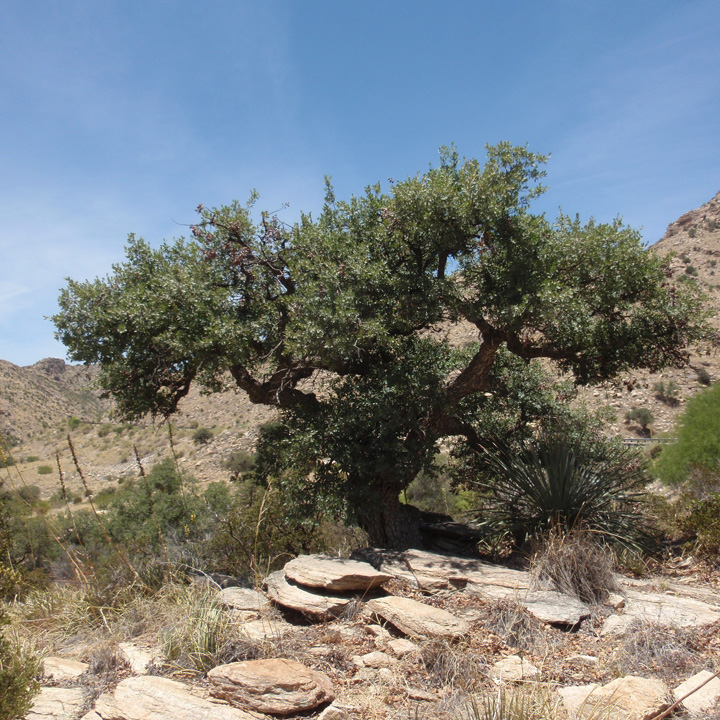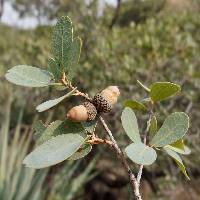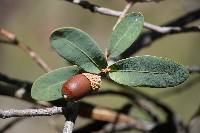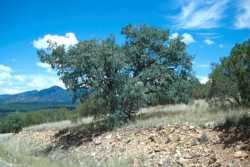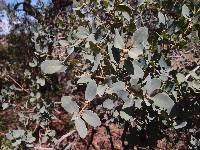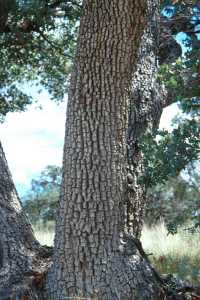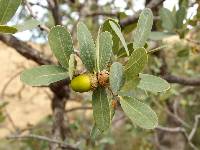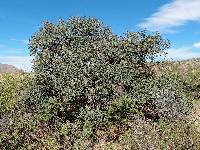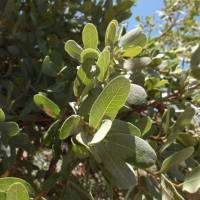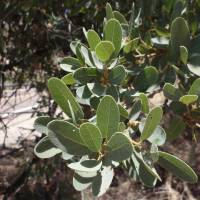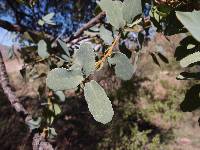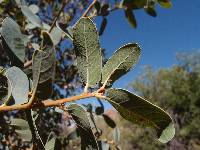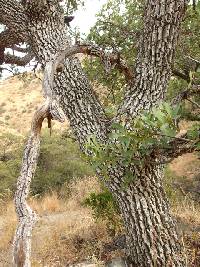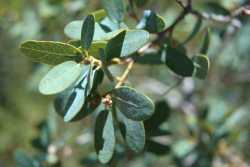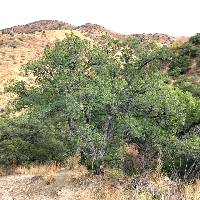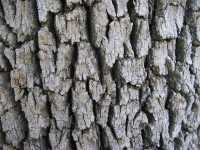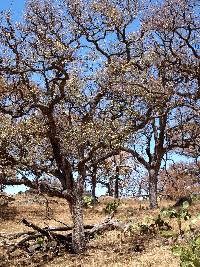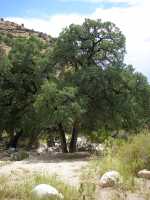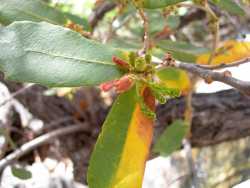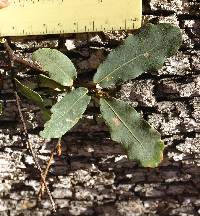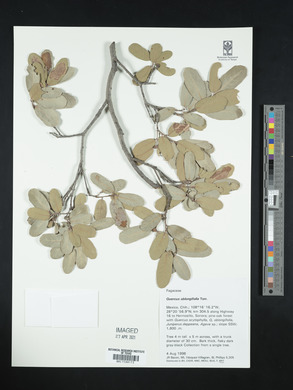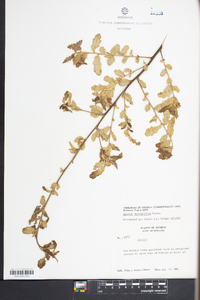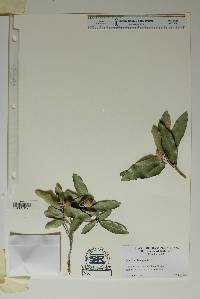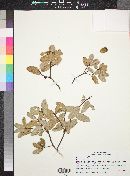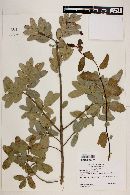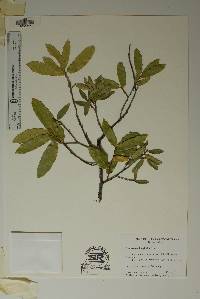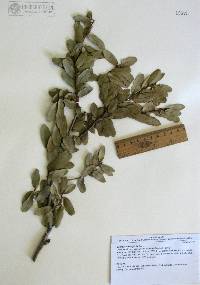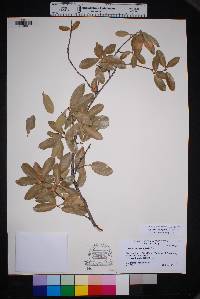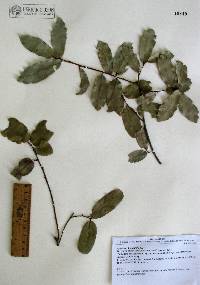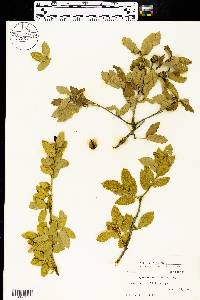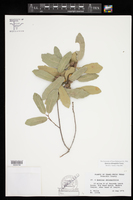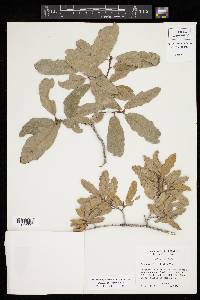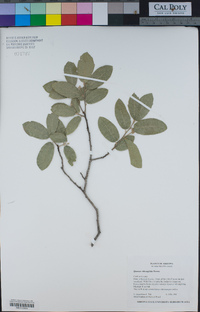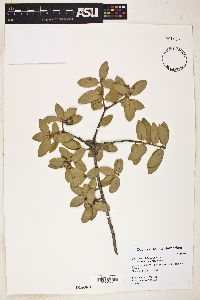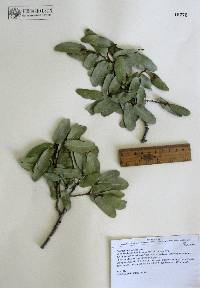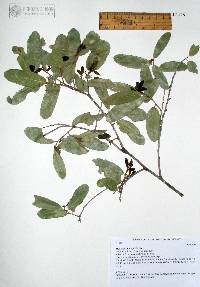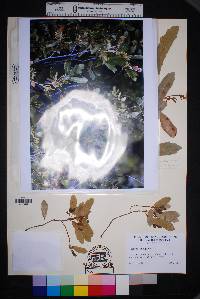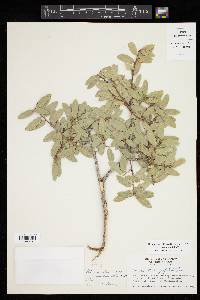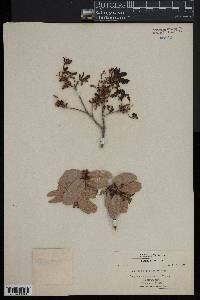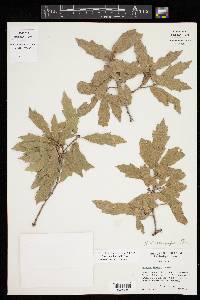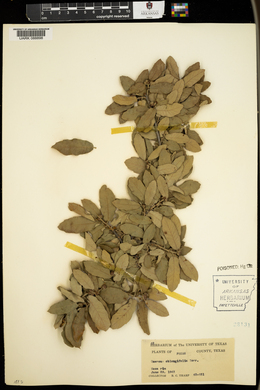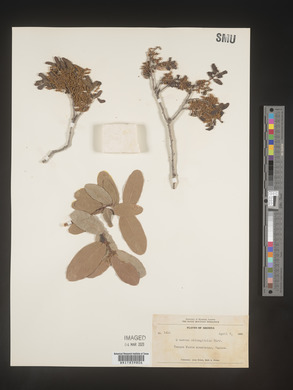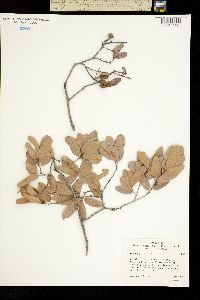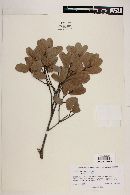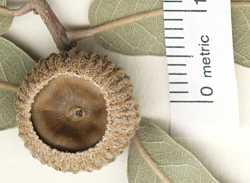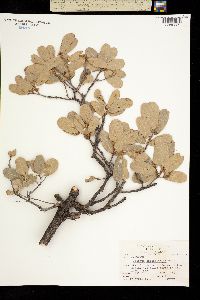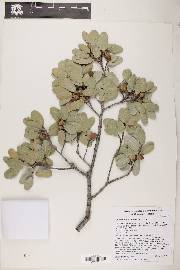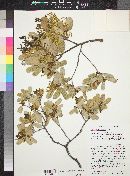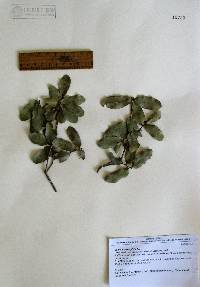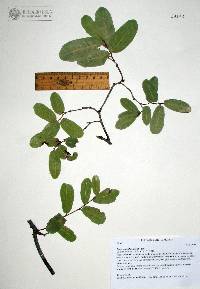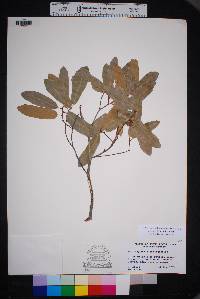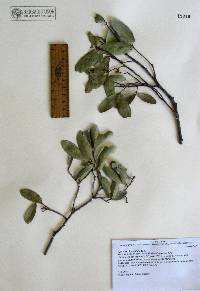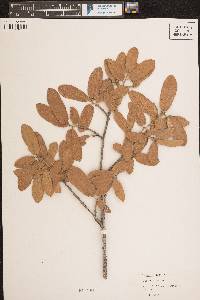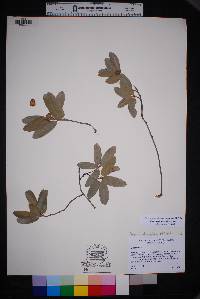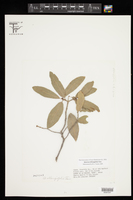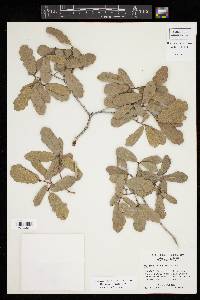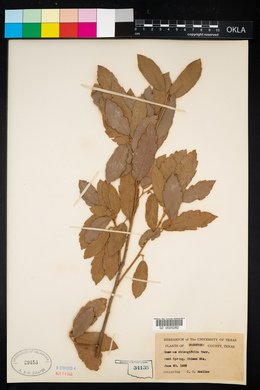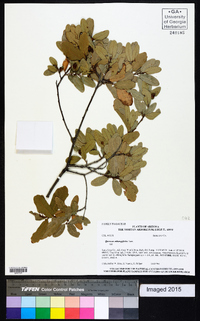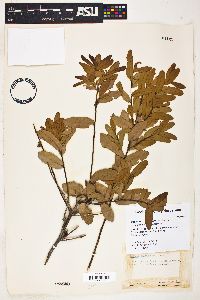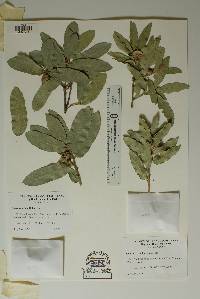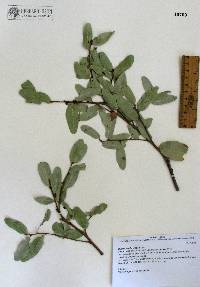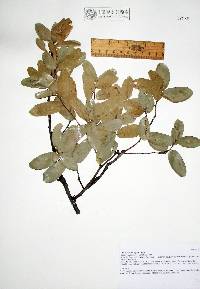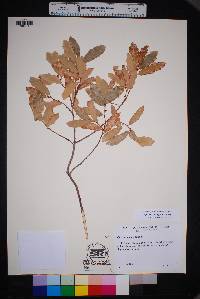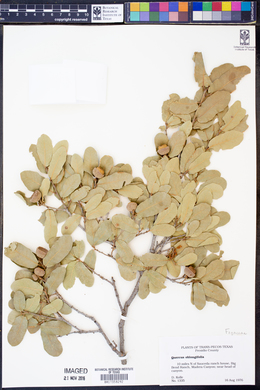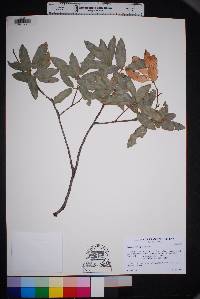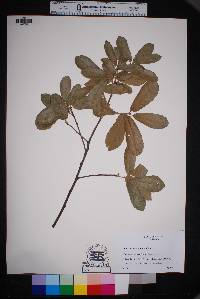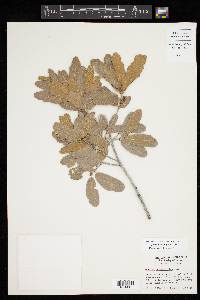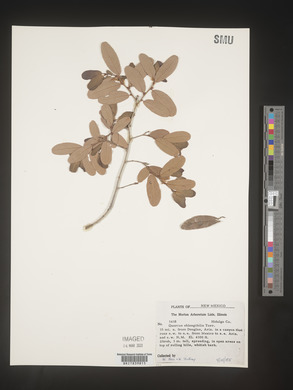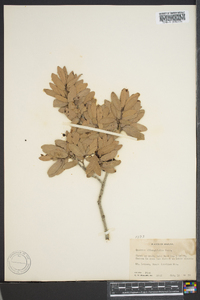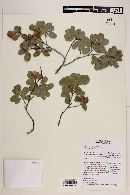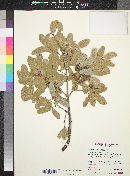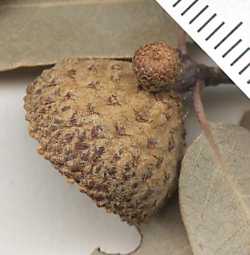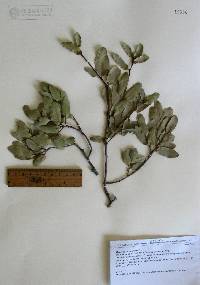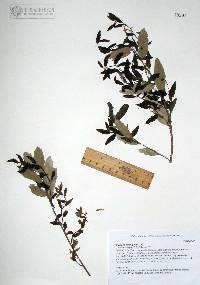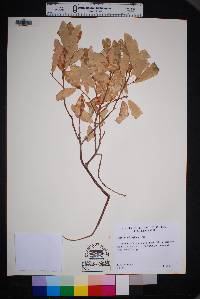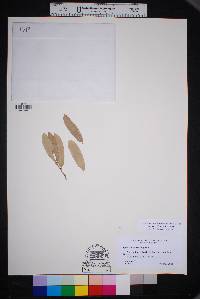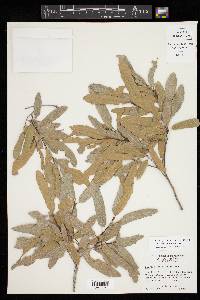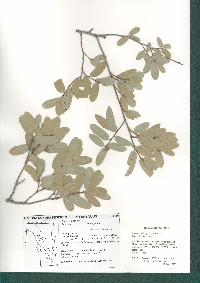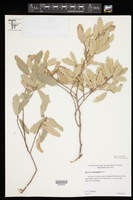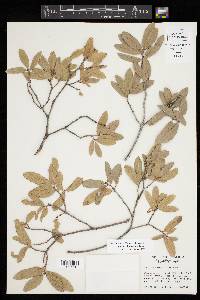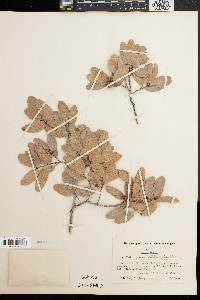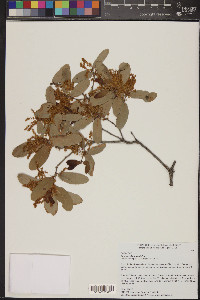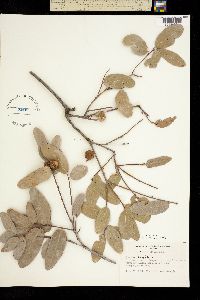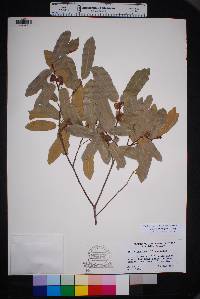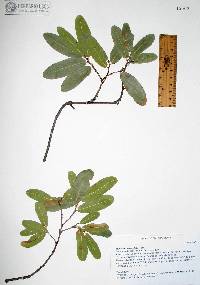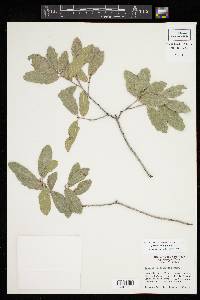
|
|
|
|
Family: Fagaceae
Sonoran Blue Oak, more...Arizona Blue Oak, Mexican Blue Oak (es: encino azul, bellota, encino)
|
Trees , evergreen, to 10 m. Bark gray or whitish, closely furrowed. Twigs light brown, 1-1.5 mm diam., densely or sparsely stellate-tomentose, soon glabrate. Buds reddish brown, subspheric to broadly ovoid, 1-2 mm, glabrous or basal scales pubescent; stipules persistent about terminal buds. Leaves: petiole 2-5(-8) mm. Leaf blade oblong to elliptic, occasionally lanceolate or ovate, (20-)30-60(-80) × (5-)10-25(-30) mm, base cuneate to cordate, margins entire, undulate, sometimes irregularly toothed especially toward apex, secondary veins 7-8(-10) on each side, branched, apex acute or broadly rounded; surfaces abaxially densely and loosely glandular-tomentose, quickly glabrate or persistently floccose, especially about base of midrib, at maturity strongly glaucous, adaxially dull pale green, bluish green, or glaucous, sparsely stellate-tomentose, quickly glabrate. Acorns solitary or paired, subsessile or on peduncle 4-12 mm; cup cup-shaped, about 6-8(-l3) mm deep × 10-13 mm wide, enclosing ca. 1/3 nut, scales to 1-1.5 mm wide, moderately, regularly tuberculate near base of cup, gray-pubescent; nut light brown, ovoid or oblong, 12-17(-19) × (7-)10-12 mm, glabrate or puberulent about apex. Cotyledons connate. Flowering in spring. Common in high grasslands and midelevation woodlands, mesas, and canyons; 1300-1650 m; Ariz., N.Mex., Tex.; Mexico (Baja California South, Sonora, Chihuahua, and Coahuila). Plant: tree; to 4-8 m high, the bark light gray, deeply furrowed; young twigs subglabrous to glabrous, gray to reddish brown, the epidermis sometimes falling in thin flakes, the older twigs usually becoming slightly roughened, lightish gray but sometimes blackened Leaves: unlobed, oval to oblong, 2-10 cm long, 1-2.7 cm wide, 1.5-4 times as long as wide, woolly when very young, glabrescent at maturity, persisting about 1 year, deciduous in spring; apex broadly obtuse to slightly emarginate; base rounded to cordate, often oblique; petiole ca. 2-4 mm long, often waxy, often reddish; midvein nearly flat or raised above, prominent below; lateral veins ca. 7-10 pairs, flat to slightly raised above, weak to moderately prominent below; secondary veins forming a reticulate pattern, visible above and below; blade coriaceous, blue-green to gray-green, nearly concolorous; margin usually entire, less often slightly sinuate INFLORESCENCE: staminate flowers in aments; pistillate flowers solitary or in groups on spikes, these sometimes abbreviated, each pistillate flower with a separate involucre Flowers: mostly wind-pollinated, unisexual, the perianth much reduced or absent; staminate flowers in heads or aments, the perianth greenish, the stamens 3-5; pistillate flowers usually tricarpellate, solitary or in clusters of about 3 or more, subtended individually or in groups by an involucre that develops into a woody cupule enclosing or subtending the mature fruit(s) Fruit: ACORNS 1-1.5 cm long; cap ca. 7 mm long, 10-15 mm across, woolly within; scales with thickened bases; nut-shell glabrous to thinly pubescent apically within Misc: In oak woodlands or scattered in grasslands; 850-1800 m (2800-6000 ft); Apr-May (fr. Oct-Nov) REFERENCES: Landrum, Leslie R. Fagaceae. 1994. J. Ariz. - Nev. Acad. Sci. Volume 27, 203-214 Landrum 1993 Common Name: Mexican blue oak Duration: Perennial Nativity: Native Lifeform: Tree General: Generally a tree from 4-8 m in height, the bark deeply furrowed and light gray. Leaves: Unlobed and lanceolate to elliptic in outline, 4-11 cm long, 1-3 cm wide, usually 3-5 times as long as wide, on petiole 2-4 mm long and a waxy reddish color, the midvein is prominent below, also they are densely white below with stellate hairs, to glabrous above, and persisting more than 1 year. Flowers: Staminate aments with reduced perianth parts, 4-12 stamens; pistillate flowers solitary or in clusters of 2-3; inferior ovary. Fruits: Acorn 1-1.5 cm long with the cupule about 7 mm long and both are 1-1.5 cm wide. Ecology: Found in the grasslands and in oak woodlands, often on gentle rolling slopes from 2,500-8,000 ft (762-2438 m), flowers April-May. Distribution: Ranges across southeastern Arizona into New Mexico to Texas and south into Mexico. Notes: This is perhaps the most oblong of the leaves of the oaks, the bluish tinge to the leaves, often being found in the open woodlands and grasslands, and the entire margins all help to identify this species. Similar to Q. chrysolepis but found in the open, where the latter is often found in the more closed forested communities. Ethnobotany: The acorns were used as food. Etymology: Quercus is the classical Latin word for oak, thought to be derived from Celtic quer, fine, and cuez, tree, while oblongifolia means oblong leaved. Synonyms: None Editor: SBuckley 2012 |
|
|
|
This project was made possible in part by the Institute of Museum and Library Services [MG-70-19-0057-19].
Powered by Symbiota

